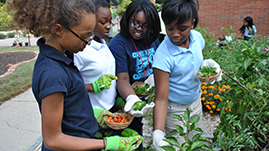Teachers' Domain - Digital Media for the Classroom and Professional Development
User: Preview



Mindful gardeners always have something to do. It might seem that a summer garden is only active for a few weeks, but actually the garden’s life cycle extends from late winter through early fall. Even in the cold, frozen days of winter, many gardeners begin nurturing tiny seeds, propping them by windows and keeping them warm with lamps.
The life and growth of a summer garden is a story that begins with the seeds of January and February and climaxes with the fruits of July and August. The success of the garden depends heavily upon timing and regular maintenance.
Once the garden plot is prepared, the garden does best if planted after the last frost of the spring and 60 to 80 days before the harvest. Along the way there is watering, weeding, staking, mulching, and picking. Seasonal changes, plant life cycles, and the work of the gardener transform the garden over time.
For many people, growing a vegetable garden is more than a hobby. It is a passion. They love to watch the first sprouts in spring and feast on the last harvest of fall. They enjoy the bounty in their freezers and pantries all year long. The rewards of gardening are on the table and in the experience.
Gardeners are immersed in the life cycles of plants. Successful development from seed to plant to produce depends on the work of the gardener. Drought, weeds, insects, and animals destroy garden plants. Watering, weeding, and using specific techniques make all the difference in gardening success.
No garden thrives without the careful attention of humans. Even where there has been a lush garden previously, few plants will sprout on their own. A gardener must plan the garden layout with proper spacing for all plants and placing seeds or transplants in the best locations. Weeds will grow with the same vigor as plants unless controlled. Most plants will sprawl out in a spindly mess unless cultivated with stakes, netting, or structures. Tomato plants, for example, do not grow as tall or produce as many tomatoes unless a stake or structure holds them up to the sun.
Several methods can be used to foster growth and save time in the garden. They include applying compost as mulch to add nutrients to the soil and help it retain moisture; placing rain barrels close to the garden for a ready source of water; and using stakes, fences, and other structures to increase plant growth and limit animal access.
Much can be learned about ecosystems through school or backyard gardening, which brings together plants, microbes, animals, and people, all living organisms with diverse needs, and non-living components such weather, water, air, and soil.
 Loading Standards
Loading Standards